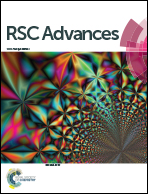Characteristics of graphene quantum dots determined by edge structures: three kinds of dots fabricated using thermal plasma jet†
Abstract
When a graphene sheet is cut along zigzag lines, carbene edges having two unshared valence electrons at each edge carbon atom are obtained, while along the armchair lines, carbyne edges having carbon triple bonds are obtained. Carbene and carbyne edges have polar and nonpolar characters, respectively. 90 degree corners are obtained when armchair and zigzag lines are encountered, while 120 degree corners are obtained when the same type of lines are encountered. Therefore, hexagonal graphene quantum dots (GQDs) are obtained when the same type of cutting lines are encountered at all the corners, while rectangular GQDs are obtained when different types of cutting lines are encountered. We have fabricated three types of GQDs by a gas phase collision reaction using a thermal plasma jet. Zigzag GQDs having only carbene edges were dispersed in polar solvents and they had basic hexagonal shapes. Armchair GQDs having only carbyne edges were dispersed in nonpolar solvents and they also had basic hexagonal shapes. Hybrid GQDs having both carbyne and carbene edges in each dot were dispersed in both polar and nonpolar solvents and had rectangular shapes. The photoluminescence and photoluminescence excitation spectra of hybrid GQDs responded to the combination of the spectra of zigzag and armchair GQDs.


 Please wait while we load your content...
Please wait while we load your content...